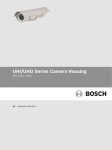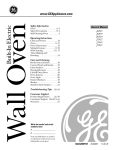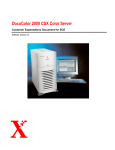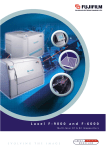Download Accel TEMPEST 3302 User's Manual
Transcript
® Tempest Hot Air Drying System Installation Instructions Ryobi 3302 Itek 3985 A.B. Dick 9985 X88-43 01/2001 Rev-B 2740 GENERAL INFORMATION ATTENTION TEMPEST® DRYER OWNER! Accel Graphic Systems provides parts and service through its authorized distributors and dealers. Therefore, all requests for parts and service should be directed to your local dealer. The philosophy of Accel Graphic Systems is to continually improve all of its products. Written notices of changes and improvements are sent to Accel Graphic Systems' Dealers. If the operating characteristics or the appearance of your product differs from those described in this manual, please contact your local Accel Graphic Systems Dealer for updated information and assistance. Always update your equipment when improvements are made available, especially those related to safety. YOUR AUTHORIZED TEMPEST® DEALER IS: THE SERIAL NUMBER OF YOUR TEMPEST® HOT AIR DRYING SYSTEM IS: CONTROL BOX FAN UNIT TECHNICAL ASSISTANCE 2 For technical assistance during the installation, please contact: ACCEL GRAPHIC SYSTEMS 11103 INDIAN TRAIL Dallas, TX 75229 PHONE (972) 484-6808 FAX (800) 365-6510 E-MAIL [email protected] WEB SITE www. accelgraphicsystems.com GENERAL INFORMATION ELECTRICAL REQUIREMENTS 220 VAC 50/60 HZ 20 AMP DEDICATED LINE NEMA L620R RECEPTACLE IMPORTANT INFORMATION The use of heat to accelerate drying may require more frequent lubrication and/or use of a high temperature lubricant in the delivery of the press. Please consult your press manufacturer for specific recommendations. SAFETY INFORMATION The Tempest® Dryer contains high voltage and hot surfaces. Never attempt to service or work on the unit unless the power is shut off and the unit is cool. Visually inspect the thermistors (Barn housed-shaped objects arranged in a honeycombed pattern on the underside of the unit) weekly. If a thermistor is damaged or cracked, do not operate the dryer. Contact Accel immediately for a replacement part. The fans should be turned on and set at the lowest speed ("0" on the dial) when running spray powder only without heat. This prevents spray powder from accumulating in the thermistors and housings. TERMINOLOGY OPS = Operator's Side NOPS = Non Operator's Side 3 GENERAL INFORMATION HOT AIR VS INFRARED WHAT MAKES TEMPEST® WORK Although the technology behind the Tempest® dryer was significant enough to be awarded the GATF Intertech Award, it is by no means new. In fact, thermistors have been in use for many years. They were originally used in motors and other devices as a heat controller and later used in refrigeration to turn compressors on and off. It is only in the last 10 years or so that thermistors have been used as a heater. Heat is generated by the thermistor because of the difficulty of electricity travelling through it when it is a conductor. The thermistor acts as a conductor until it reaches its set temperature and then it becomes a resistor. A thermistor is basically a coated semiconductor designed to switch from a conductor to a resistor at an established temperature. When a current is applied to the thermistor it initially uses a large amount of electricity and heats up very quickly until it reaches its maximum set temperature. At this point it should not use any more electricity. However, air that is passed through the holes in the thermistor causes it to cool. This activates the thermistor to start using more power again so that can get back to its set temperature. The thermistor is constantly regenerating itself to stay at a constant temperature. This process is called autostabilization. Thermistors are also the key element that makes the Tempest® dryer safe. Because the set temperature of the thermistor is lower than the flash point of paper, you can place even the most easily burned substrate (such as tissue paper) on top of the thermistor element without causing a fire. The tissue won't even char, let alone ignite. If you were to do the same with an IR element, a fire could start in a matter of seconds. This is particularly important if a jam occurs in the delivery. The objective of any drying system is to raise the pile temperature to accelerate the drying of the ink. However, heating the paper too much can aggravate problems such as blocking, setoff, mottle, loss of gloss, and loss of halftone definition. Too much heat can also cause the paper to shrink which can cause register problems in multiple pass work. The Tempest® dryer can keep the pile at a lower temperature than IR and still effectively set the ink film. 4 GENERAL INFORMATION IR dryers use very high temperatures and a fixed amount of electricity. One of the drawbacks of using a very hot heat source is that heat wants to travel from a very high temperature to a very low temperature. In other words, the heat generated from an IR dryer will travel to the press wall and attempt to increase its temperature because it is cooler than the heat produced by the IR dryer. Because the thermistors used in the Tempest® dryer use lower temperatures, the heated air has had time to cool by the time it reaches the wall of the press, reducing the chance of premature wear to press parts. HOW DRYING IS ACCOMPLISHED WITH TEMPEST® Tempest® "sets" the surface of the ink to prevent set-off from one sheet to another and to minimize the use of powder. KEY FACTORS TO REMEMBER ABOUT DRYERS FOR SMALL OFFSET PRESSES. Do not expect a dryer to "instantly" dry the ink. Only UV inks and coating dry instantly. The technology and hazards of such systems make them cost prohibitive on small offset presses. Tempest® accelerates the final drying of oil based inks by raising the temperature of the delivery stack. Some jobs may require spray powder. Because dryers for small offset presses do not dry ink instantly, powder will be required from time to time. However, you should expect to see a significant decrease in the amount of powder needed on a regular basis. Drying time is dependent upon press speed, paper stock, ink coverage, type of ink, etc. Do not expect a dryer to accelerate the drying of rubber based inks. These inks dry by absorption into the stock, and heat does not accelerate this process. 5 6 INSTALLATION 1 DISCONNECT THE POWER TO THE PRESS BEFORE BEGINNING INSTALLATION. Remove the two large side covers over the main framework of the press (one at OPS and one at NOPS) and the NOPS cover at the delivery end of the press. For an easier installation, you may also want to remove the two guards on the delivery end of the press. 2 NOTE: Do not cut the hose if the press is equipped with an Airtech sprayer. Cut the sprayer hose about halfway between the hopper and the spray bar. A new hose will be attached to the spray mechanism. 3 NOTE: Do not remove the spray bar if the press is equipped with an Airtech sprayer. Remove the spray bar by removing the two bolts holding the bracket (subject arrow). Also remove the clip holding the spray hose (subject arrow, picture on following page). 7 8 INSTALLATION 4 5 Remove the chain guide (subject arrow) at the OPS & NOPS sides of the press. Install the mounting bracket and new chain guide using M5 X 16MM cap head bolts and lock washers (subject arrow) as shown at the OPS & NOPS. Leave the bolts loose so the position of the dryer can be moved up and down. The bolts thread into the same holes that held the original chain guides. 9 10 INSTALLATION 6 Note: If the press is equipped with an Airtech sprayer, you must remove the spray bar from the dryer before installing it in the press.To remove the spray bar from the dryer, remove the three screws on the top of the dryer. Set the dryer on the brackets with the cable exiting at the NOPS. Run the cable under the mounting bracket (subject arrow, left picture) and through the large hole in the side frame (subject arrow, lower picture) directly under the mounting bracket. 7 Secure the dryer to the brackets (four places) using the short button head bolts, washer, and flanged nut (subject arrows). Leave the bolt loose so the dryer can be moved front to back. 11 12 INSTALLATION 8 9 Position the dryer so it clears the gripper opening mechanism on all three delivery gripper bars. The arm must clear both the top and bottom of the dryer. The photo shows the arm clearing the top of the dryer (subject arrow). After positioning the dryer, tighten the bolts holding the mounting brackets to the press frame and the bolts holding the dryer to the mounting brackets. NOTE: If the press is equipped with an Airtech sprayer, proceed to step 11. Attach two hoses to the elbows in the sprayer housing (subject arrow, upper picture) and run the hose through the hole in the side frame (subject arrow, lower picture ). Note how the hoses are tied together with a zip tie in the upper picture on the left hand side. 13 14 INSTALLATION 10 11 12 Connect the two hoses together using the "Y" connector (left hand subject arrow). Connect the Tempest® Spray line to the press spray hopper line using the reducer (right hand subject arrow). Attach the exhaust fan/manifold assembly to the center of the delivery guard as shown. Make sure that the arrow on the fan is pointing toward the guard (out of the press) and that the wires are routed toward the NOPS of the press. The top two screws go through the second slot down from the top of the guard. Make sure that the open end of the manifold is pointing toward the NOPS. You will need to file the openings in the guard so that the screws will pass through the guard. Locate the 2 impression cylinder activation solenoids located on the OPS of the press, one under each head. Remove the 2 outside nuts and screws from each solenoid (lower subject arrows). Install the provided longer M4 x 16MM screws. Install the supplied switch assemblies (as shown in the picture) over the screws and secure them using the original hardware. The left photo show the #1 head solenoid and the right shows the #2 head solenoid. Note how the microswitch trip arms extend up to the spring studs located on activation linkage (upper subject arrows). 15 16 INSTALLATION 13 14 15 Attach the microswitch cable assembly to the microswitch's installed in step 12. See diagram for proper connection. Find a suitable location for the main Tempest electrical box on the NOPS of the press. Route the exhaust fan cable (this cable has female pins in the connector on the end) into the delivery and connect it to the exhaust fan installed in a previous step. Route the impression signal cable (this cable has male pins in the connector on the end) through the press and connect it to the the cable that was attached to the micro-switches installed in the previous step. Use the provided tie-wraps to secure the cable as necessary to clear any moving parts of the machine. Remove the cover from the main Tempest® electrical cabinet and insert the dryer cable through the strain relief on the bottom of the box. Insert the wires into the green connector by matching the number on the wire to the number on the connector. Secure the ground wire to the stud on the inside of the box. Tighten the strain relief and replace the cover on the box. 17 18 INSTALLATION 16 17 18 Remove one of the two screws that attach the guard prop to the delivery guard on the NOPS. Install the supplied longer M4 screw in its place and using the original nut secure the provided cable clamp (subject arrow) to the underside of the guard. Make sure you have the exhaust fan cable going through the clamp before securing it to the guard. Place the larger heat shield in the delivery as shown. Place the small heat shield in the delivery and attach it to the larger shield, with two 10-32 x 1/4 button head screws and flat washers. 19 20 INSTALLATION 19 Use the provided zip ties to secure all loose cables. See the back of the manual for a complete electrical system diagram. Replace all covers and guards. Attach the supplied multiple power cord caution label to the press side NOPS cover. 20 21 OPERATION & MAINTENANCE HOW DRYING IS ACCELERATED WITH TEMPEST® Tempest® creates a two-step drying process when used with oil-base inks. These steps are: 1. Skinning the surface of the ink with the initial blast of hot air to prevent set off. 2. Accelerating the final drying process approximately 20o F over the cold stack temperature in the feeder. Heat accelerates the drying process, called oxidation and reduction, of oil-based inks. In general, dryers including infrared do not work well with rubber or acrylic-based inks. These inks should be avoided when maximum results are desired. HOW TEMPEST® WORKS 1. When voltage is applied to the thermistors (triangular shaped objects arranged in a honeycomb pattern), the thermistors begin to heat. (Thermistors are coated semiconductors). 2. Thermistors heat to a predetermined temperature, in this case about 400o F, and remain at that temperature. This is known as autostabilization. 3. The fans blow air down towards and through the thermistors, creating a flow of hot air to the sheet. 4. Drying of the ink occurs in the two-step process as described above. No dryer totally eliminates the need for spray powder. There may be some jobs, for example, a heavy solid on a high gloss sheet where powder is required. Overall, Tempest® should reduce your spray powder usage significantly, leaving you with a better printed product and cleaner working environment. TEMPEST ® OPERATION 22 ON/OFF OPERATION The switch is located on the side of the Tempest® box which provides power to the box. Select 1 for on and 0 for off. OPERATION & MAINTENANCE NORMAL OPERATION Pressing the HEAT switch will illuminate both the green and yellow LEDs on the remote control unit. The green LED indicates that the fans (both dryer and exhaust fans if so equipped) are running while the yellow LED indicates that the dryer is armed and the heat will come on automatically when the press goes on impression. When the press does go on impression, the green LED will illuminate indicating that the heat is on. Pressing the heat button again will disarm the heat mode but the fans will continue to run. To turn the unit OFF press the FAN switch at any time. FAN ONLY OPERATION To operate only the fans, press the FAN switch. The green LED will illuminate and the fans will come on (both the dryer and exhaust fans if so equipped). The heat mode of the dryer is not armed and will not come on with impression. To turn the fans OFF press the FAN switch again. FAN SPEED CONTROL To adjust the fan to a higher setting, press the up arrow on the remote control unit. To decrease the fan speed press the down arrow on the remote. The fans will automatically go to the minimum speed setting for a few seconds when the press goes on impression and then they return to the previous setting. This reduction in fan speed allows the dryer to heat up more quickly. INITIAL SETTINGS Try running Tempest® with the fan speed at "4" with the switch on "HEAT." After about 1" of paper is stacked in the delivery, insert the thermometer into the center of the stack. Allow the thermometer to stabilize. It should be approximately 20o F above the initial pile temperature. If the temperature is below that, decrease the fan speed slightly. If the temperature is above that, increase the fan speed slightly. 23 OPERATION & MAINTENANCE FACTORS THAT EFFECT DRYING 1. 2. 3. 4. Speed of the press. Amount of ink coverage and color. Type of stock being printed. Initial temperature of paper. In time and with practice you will learn which settings are best for your particular shop. KEYS TO REMEMBER 1. The Tempest® takes about 12 sheets to come up to full power. The dryer remains on as long as paper is being fed. It does not cycle like an infrared dryer. 2. The pile temperature should be approximately 20o F above the initial pile temperature for optimum drying. 3. Use spray powder only when absolutely necessary. A little spray powder goes a long way. Use it sparingly. 4. Inspect the Tempest® weekly. MAINTENANCE 1. Inspect the dryer weekly. If the thermistors are cracked or have been damaged, do not operate the dryer. Call Accel immediately. 2. Never squirt cleaning solvents, water, or any other liquids into the dryer. This may damage electrical components. 3. Any spray powder that accumulates in the dryer should be vacuumed out, not blown out. 4. Make sure all heat shields and guards are in place before operating the dryer or printing press. 5. When solvents are used to clean the rollers or blanket be sure that the solvent does not get in direct contact with the dryer (don't store or use solvents in the surrounding of the dryer). 24 6. When spraypowder is used in the environment of the dryer the delivery needs to be cleaned weekly to avoid danger of ignition, or make use of ignition free spraypowder. Shut off main power of the press/dryer and sprayer before cleaning the press. OPERATION & MAINTENANCE SAFETY REQUIREMENTS 1. Accel equipment should only be installed by an authorized dealer or distributor. 2. Only use ink or varnish that are explosion safe when used with the Tempest®. (Refer to the MSDS of ink in use) 3. Make sure to visually check the delivery that the cables in use are not causing a dangerous situation while in operation. 4. When a dryer is installed the function of the original safety guards may not be changed in a way that the press or dryer is not reacting in case of an emergency. 25 26 27 28 29 30 31 32 33 34 35 36 37 38 39 40 41 11103 Indian Trail, Dallas, TX 75229 Phone 972-484-6808, Fax 800-365-6510 E-mail [email protected], Web Site www.accel-us.com




















































